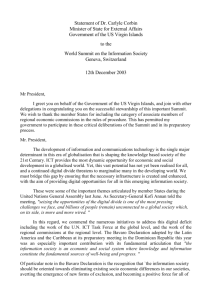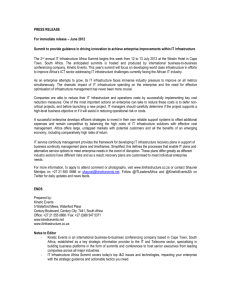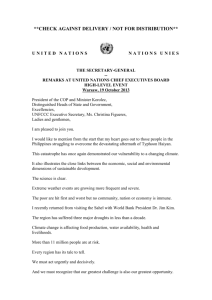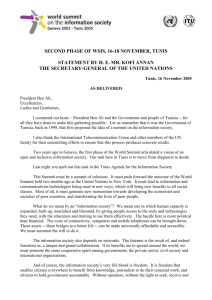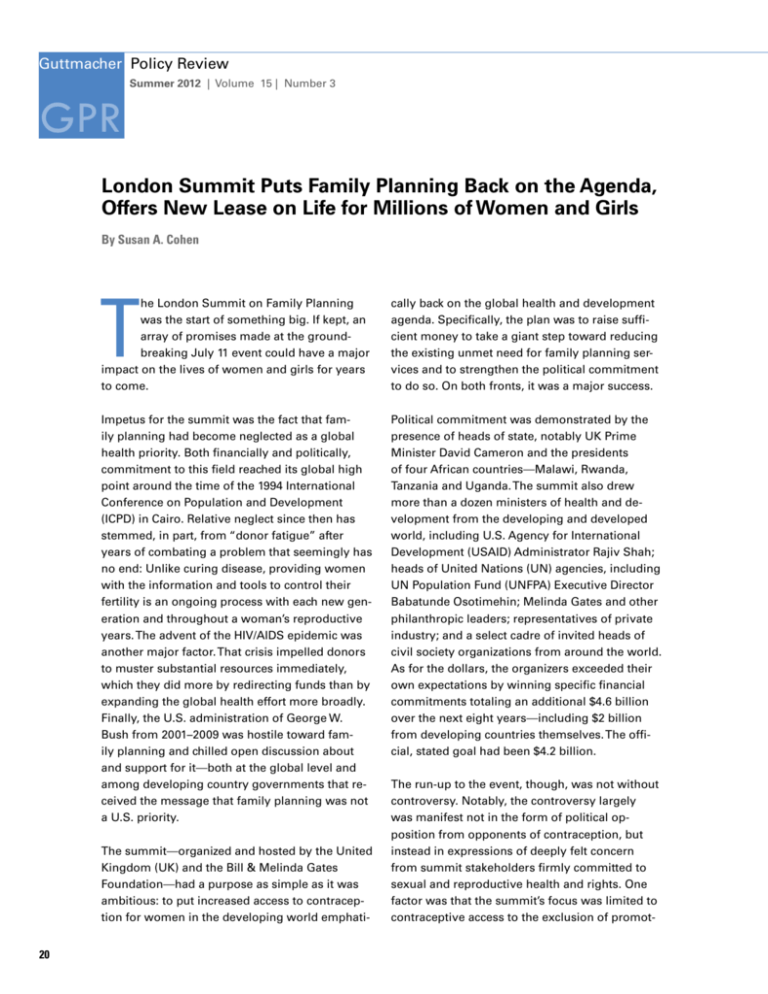
Gut tmacher Policy Review
Summer 2012 | Volume 15 | Number 3
GPR
London Summit Puts Family Planning Back on the Agenda,
Offers New Lease on Life for Millions of Women and Girls
By Susan A. Cohen
T
he London Summit on Family Planning
was the start of something big. If kept, an
array of promises made at the groundbreaking July 11 event could have a major
impact on the lives of women and girls for years
to come.
cally back on the global health and development
agenda. Specifically, the plan was to raise sufficient money to take a giant step toward reducing
the existing unmet need for family planning services and to strengthen the political commitment
to do so. On both fronts, it was a major success.
Impetus for the summit was the fact that family planning had become neglected as a global
health priority. Both financially and politically,
commitment to this field reached its global high
point around the time of the 1994 International
Conference on Population and Development
(ICPD) in Cairo. Relative neglect since then has
stemmed, in part, from “donor fatigue” after
years of combating a problem that seemingly has
no end: Unlike curing disease, providing women
with the information and tools to control their
fertility is an ongoing process with each new generation and throughout a woman’s reproductive
years. The advent of the HIV/AIDS epidemic was
another major factor. That crisis impelled donors
to muster substantial resources immediately,
which they did more by redirecting funds than by
expanding the global health effort more broadly.
Finally, the U.S. administration of George W.
Bush from 2001–2009 was hostile toward family planning and chilled open discussion about
and support for it—both at the global level and
among developing country governments that received the message that family planning was not
a U.S. priority.
Political commitment was demonstrated by the
presence of heads of state, notably UK Prime
Minister David Cameron and the presidents
of four African countries—Malawi, Rwanda,
Tanzania and Uganda. The summit also drew
more than a dozen ministers of health and development from the developing and developed
world, including U.S. Agency for International
Development (USAID) Administrator Rajiv Shah;
heads of United Nations (UN) agencies, including
UN Population Fund (UNFPA) Executive Director
Babatunde Osotimehin; Melinda Gates and other
philanthropic leaders; representatives of private
industry; and a select cadre of invited heads of
civil society organizations from around the world.
As for the dollars, the organizers exceeded their
own expectations by winning specific financial
commitments totaling an additional $4.6 billion
over the next eight years—including $2 billion
from developing countries themselves. The official, stated goal had been $4.2 billion.
The summit—organized and hosted by the United
Kingdom (UK) and the Bill & Melinda Gates
Foundation—had a purpose as simple as it was
ambitious: to put increased access to contraception for women in the developing world emphati20
The run-up to the event, though, was not without
controversy. Notably, the controversy largely
was manifest not in the form of political opposition from opponents of contraception, but
instead in expressions of deeply felt concern
from summit stakeholders firmly committed to
sexual and reproductive health and rights. One
factor was that the summit’s focus was limited to
contraceptive access to the exclusion of promot-
ing greater access to safe abortion services. A
more widespread concern, however, was that the
summit’s overriding emphasis on quantitative
goals—notably, an additional 120 million contraceptive users in the world’s 69 poorest countries
by 2020—could open the door to the return of a
discredited “population control” mentality and
coercive practices on the ground. On this point,
the policy statements issued by the organizers
by the time of the event itself were much clearer.
Indeed, the theme that women’s rights must be
at the center of all implementation efforts was repeatedly reinforced during the proceedings. Even
so, how this plays out going forward remains a
legitimate concern.
Needs and Costs
information about the advantages and sides effects of the various methods, and that a greater
array and reliable supply of method options are
available, so that a woman is better able to match
her personal needs with the method that works
best for her at any given point in her reproductive
life. Meaningful access also depends on a woman
being unencumbered, by law and custom, so she
is able to make those choices on her own.
According to the Guttmacher-UNFPA report, the
combination of doing better by the women currently receiving family planning services and responding to the needs of the women still left out
would cost about double the $4 billion currently
being spent. The estimate is comprehensive,
including the cost of the contraceptive supplies;
personnel for counseling, clinical care, method
provision and follow-up; and expenses necessary
to maintain and strengthen health service delivery, including staff training and supervision, family planning education and advocacy, construction
of facilities, development of logistics systems,
and management.
In preparation for the summit, the Guttmacher
Institute and UNFPA produced a new analysis
of the total unmet need for contraceptive services in all developing countries. According to
Adding It Up: Costs and Benefits of Contraceptive
Services—Estimates for 2012, some 645 million
women throughout the developing world currently rely on modern contraceptives—male or
The payoff, however, would far exceed the cost.
female sterilization, IUDs, implants, injectables,
Each dollar invested in meeting all the need
pills, condoms or spermicides—to prevent or
Modern method
would save $1.40 that otherwise
would be spent
delay pregnancy.1 But 222 million women who
on maternal and newborn health care for women
are sexually active and do not want a child in the
No method or traditional method
whose pregnancies were unintended in the first
next two years or ever either rely on traditional
methods of birth control—withdrawal or periodic
abstinence—or use no method at all. The goal
UNMET NEED FOR MODERN METHODS
of the summit is to reach 120 million of these
Only 26% of the developing world’s women who want to avoid pregnancy are not
women in the world’s poorest countries over the
using a modern method of birth control, but they account for 79% of unintended
next eight years.
pregnancies each year.
The focus on reaching women not using a modern contraceptive method is entirely understandable: Although the 222 million women in this
category comprise only about one-quarter of all
women wishing to avoid pregnancy, they account
for the vast majority of unintended pregnancies (see chart). That said, two in 10 unintended
pregnancies occur to women who are using a
modern method. Clearly, then, providing mere
access to a contraceptive method is not enough.
Contraceptive failure results from incorrect or
inconsistent use, and from imperfect methods.
Meaningful access to family planning, therefore,
must include ensuring that women have better
Guttmacher Policy Review | Volume 15, Number 3 | Summer 2012
CONTRACEPTIVE
USE
UNINTENDED
PREGNANCIES
26%
21%
2.5%
79%
74%
19.5%
867 million
No method or traditional method
80 million
Modern method
Source: reference 1.
Modern method
No method or traditional method
21
Addressing the Unmet Need
in the Developing World
222 million
more women using
modern methods
54 million
unintended
pregnancies averted
26 million
abortions averted
21 million
unplanned births averted
7 million
miscarriages averted
1.1 million
newborn and infant deaths averted
79,000
maternal deaths averted
Source: reference 1.
22
place. This would free up more resources for
desperately needed improvements in obstetric
and neonatal care, which would benefit many of
the same women when they have wanted pregnancies. Globally, the current $4 billion invested
in family planning is already saving $5.6 billion
in maternal and newborn health services alone;
investing the full $8 billion to meet all the need
for family planning services would mean averting
more than $11 billion in expenditures.
Even more important than the dollars saved,
family planning protects health and saves lives.
Effectively meeting all of the need for modern
contraception just among the women currently
not using a modern method would cause the
number of unintended pregnancies to drop by
two-thirds. This would lead to dramatic declines
in the numbers of abortions (mostly medically
unsafe), unplanned births, miscarriages, and
maternal and infant deaths (see chart). By far,
the largest number of maternal deaths averted
would be in Sub-Saharan Africa, the region with
the highest levels of maternal deaths and unmet
need for modern contraception.
Legitimate Concerns
In announcing plans for the summit, Melinda
Gates made clear from the outset that abortion would not be on the agenda. A practicing
Catholic whose foundation does not fund abortion, Gates has recently become an impassioned
advocate for family planning based on her encounters with local women in the urban slums
and remote villages she has visited around the
world. The summit’s avoidance of the abortion
issue did not quell attacks from a few antiabortion fringe groups, which insist that any discussion of contraception is always code for a desire
to promote abortion. More importantly, it sparked
strong objections from global reproductive
rights activists, who maintained—and some still
do—that any high-level gathering relating to any
aspect of reproductive health that stops short
of grappling with the importance of increasing
access to safe abortion services further marginalizes a critically important issue.
Beyond abortion, however, early preparations
for the summit alarmed reproductive rights ad-
Summer 2012 | Volume 15, Number 3 | Guttmacher Policy Review
vocates, who feared that the specter of coercion
and discrimination might be creeping back into
the sexual and reproductive health field. At the
landmark Cairo conference, a global consensus
emerged explicitly rejecting the concept of “population control” and demographic targets. The
core principle of the 1994 ICPD that has guided
the global cause since then rests on the premise
that it is a basic human right of all individuals to
determine for themselves whether and when to
have a child, and it is the responsibility of government and society to protect, promote and help
women, men and adolescents realize that right.
By contrast, most of the early descriptions of
plans for the summit emphasized metrics and
targets for increasing the number of contraceptive users and included little about safeguarding women’s rights, enhancing informed choice
or promoting equity. As International Women’s
Health Coalition President Francoise Girard put
it several weeks prior to the event, “We welcome
more funding for family planning services, but
not if it comes with targets and incentives for
doctors to pressure women to ‘accept’ contraceptives. That formula leads to coercion of women,
plain and simple.”2
As the summit approached, it became clear that,
on abortion, there would simply have to be an
agreement to disagree. Assuredly, advocates
from civil society organizations and the donor
community—and some country governments—
will keep up the pressure in other fora to move
forward on the agenda to reduce the number of
medically unsafe abortions that still kill about
47,000 women each year and maim millions
more.3 Indeed, Gates’ summit cohost, the British
government, is one of the world’s leaders in recognizing unsafe abortion as a global public health
problem and in supporting efforts to redress it.
Even at the summit itself, the Dutch government’s
representative, for example, took the opportunity
to emphasize that while access to safe abortion
was not a topic for this initiative, it would remain
a key priority within the Netherlands’ sexual and
reproductive health and rights program.
As for the embrace of the broader ICPD approach
to family planning, the major speakers and all the
materials disseminated at the summit itself could
Guttmacher Policy Review | Volume 15, Number 3 | Summer 2012
not have been clearer. This initiative firmly rejects
population control, coercion and discrimination.
It hinges on a rights-based, women-centered approach that promotes greater access to services
through enhancing informed choice and equity.
Looking forward to implementation efforts, vigilance will be required to make sure that actions
hew to the promises made. An “accountability
annex” released just after the summit by the UK
development agency and the Gates Foundation,
however, is an encouraging sign. It declared that
the whole exercise is “about more than new
money; it is about changing business as usual.”
The plan is to increase demand and support for
family planning in a way that also removes barriers to access and use. There will be a big push
to improve the supply and distribution of contraceptives, as well as develop new and better
technologies, toward the goal of expanding real
choice of methods. There will be an emphasis on
monitoring and evaluation with a special focus
on measuring improved quality of services and
information to women to promote truly informed
and voluntary choice. And there will be a focus
on supporting advocacy around sustaining and
increasing funding, but also on “protect[ing] and
promot[ing] global commitments to family planning within the ICPD framework for sexual and
reproductive health and rights.”
Breaking Through
Because political commitment is as essential as
financial commitment to any cause, the mere
presence of so many dignitaries from around the
globe at the summit made a powerful statement.
But the financial commitment was surprisingly
strong, too.
Among developing countries, Nigeria pledged
to triple its budget support for family planning,
enhance the manufacturing of contraceptive
supplies domestically and focus on education
of girls. Senegal promised to double its existing investment, focusing on increasing contraceptive supplies, mass media campaigns,
community-based distribution efforts and mobile
clinics—critical steps in this country that has
one of the world’s lowest rates of contraceptive use. Important commitments were made by
23
nine other countries in Africa, as well as India,
Indonesia and the Philippines. Together, these
developing countries pledged $2 billion in new
funding by 2020 for the wide array of activities
that will be necessary to improve services to their
own people.
The donors, including governments, philanthropies and pharmaceutical companies, brought
$2.6 billion in new pledges to the table. The single
largest pledge came from the British government, which will double its contribution over the
next eight years with an additional $800 million.
The Gates Foundation will double its commitment with an additional $560 million over the
same period, bringing its support for family planning into line with its other major global health
initiatives. And pharmaceutical companies made
important pledges toward increased availability
of low-or no-cost contraceptives, including injectables, implants and female condoms.
The United States—which remains the single
largest family planning donor at $610 million this
year—was not in a position to commit new funds.
USAID Administrator Shah did assert, however,
that family planning will continue to be a high
priority under the Obama administration. In particular, the United States will step up its efforts in
the area of contraceptive research and development, especially highly effective methods that
can be used in low-resource settings. The United
States is leading a drive to develop an effective
“multipurpose” technology, besides condoms,
that will help women simultaneously prevent unintended pregnancy and STIs, including HIV.
Amidst the pledges, there were many rousing
speeches. It was UK Prime Minister Cameron,
though, who brought down the house. Helping
women to have the information and services
necessary to decide freely whether, when and
how many children to have, he proclaimed, is
not just nice, “it’s absolutely fundamental to any
hope of tackling poverty in our world.”4 When a
woman has “opportunity, resources and a voice,”
he said, “the benefits cascade to her children, her
community and her country. So family planning
is just the first step on a long journey towards
growth, equality and development.”
24
Cameron took on some of the well-entrenched
canards about family planning programs as
well. He chided “those who say we shouldn’t
interfere….We’re not talking about some kind
of Western imposed population control, forced
abortion or sterilization. What we’re saying today
is quite the opposite….We’re giving women and
girls the power to decide…. And to those who try
to say it is wrong to interfere by giving a woman
that power to decide, I say they are the ones who
are interfering, not me….Because there are no
valid excuses for the denial of basic rights and
freedoms for women around the world.”
But it is perhaps Melinda Gates who makes the
case most simply for the goals of the summit
and for what she terms “a totally uncontroversial
idea.”5 That is: All women should be free to decide
whether and when to have a child and should
have access to modern contraception to help
them act on those decisions. www.guttmacher.org
This article was made possible by a grant from the
United Nations Foundation. The conclusions and
opinions expressed in this article, however, are those
of the author and the Guttmacher Institute.
REFERENCES
1. Singh S and Darroch JE, Adding It Up: Costs and Benefits of
Contraceptive Services—Estimates for 2012, New York: Guttmacher
Institute and United Nations Population Fund (UNFPA), 2012, <http://
www.guttmacher.org/pubs/AIU-2012-estimates.pdf>, accessed July
20, 2012.
2. Center for Reproductive Rights, Global advocates: family planning
summit must put women’s human rights first, June 20, 2012, <http://
reproductiverights.org/en/press-room/global-advocates-family-planningsummit-must-put-womens-human-rights-first>, accessed July 20,
2012.
3. Guttmacher Institute, Facts on induced abortion worldwide, In Brief,
New York: Guttmacher Institute; and Geneva: World Health
Organization, 2010, <http://www.guttmacher.org/pubs/fb_IAW.pdf>,
accessed July 20, 2012.
4. David Cameron’s speech on family planning in full, July 11, 2012,
<http://www.politics.co.uk/comment-analysis/2012/07/11/davidcameron-s-speech-on-family-planning-in-full>, accessed July 20, 2012.
5. TED, Melinda Gates: Let’s put birth control back on the agenda, April
2012, <http://www.ted.com/talks/melinda_gates_let_s_put_birth_
control_back_on_the_agenda.html>, accessed July 20, 2012.
Summer 2012 | Volume 15, Number 3 | Guttmacher Policy Review




